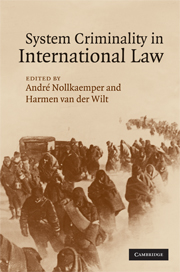Book contents
- Frontmatter
- Contents
- Preface
- Table of cases
- Table of treaties and international instruments
- List of abbreviations
- List of contributors
- 1 Introduction
- 2 The policy context of international crimes
- 3 Why corporations kill and get away with it: the failure of law to cope with crime in organizations
- 4 Men and abstract entities: individual responsibility and collective guilt in international criminal law
- 5 A historical perspective: from collective to individual responsibility and back
- 6 Command responsibility and Organisationsherrschaft: ways of attributing international crimes to the ‘most responsible’
- 7 Joint criminal enterprise and functional perpetration
- 8 System criminality at the ICTY
- 9 Criminality of organizations under international law
- 10 Criminality of organizations: lessons from domestic law – a comparative perspective
- 11 The collective accountability of organized armed groups for system crimes
- 12 Assumptions and presuppositions: state responsibility for system crimes
- 13 State responsibility for international crimes
- 14 Responses of political organs to crimes by states
- 15 Conclusions and outlook
- Index
11 - The collective accountability of organized armed groups for system crimes
Published online by Cambridge University Press: 08 October 2009
- Frontmatter
- Contents
- Preface
- Table of cases
- Table of treaties and international instruments
- List of abbreviations
- List of contributors
- 1 Introduction
- 2 The policy context of international crimes
- 3 Why corporations kill and get away with it: the failure of law to cope with crime in organizations
- 4 Men and abstract entities: individual responsibility and collective guilt in international criminal law
- 5 A historical perspective: from collective to individual responsibility and back
- 6 Command responsibility and Organisationsherrschaft: ways of attributing international crimes to the ‘most responsible’
- 7 Joint criminal enterprise and functional perpetration
- 8 System criminality at the ICTY
- 9 Criminality of organizations under international law
- 10 Criminality of organizations: lessons from domestic law – a comparative perspective
- 11 The collective accountability of organized armed groups for system crimes
- 12 Assumptions and presuppositions: state responsibility for system crimes
- 13 State responsibility for international crimes
- 14 Responses of political organs to crimes by states
- 15 Conclusions and outlook
- Index
Summary
Introduction
The analytical starting point of the present book is that massive violations of human rights and of the law of armed conflict are committed as part, or with the involvement, of a collective entity, a ‘system’, which constitutes a central element of the enabling context for their commission. Accordingly, the examination of crimes of genocide, crimes against humanity and war crimes would remain incomplete if one were to lose sight of this systemic environment and were to conceive of these crimes as solely a matter of criminal responsibility, with its focus on individual perpetrators. However, such an examination would run the risk of perpetuating incompleteness, were it to be limited to the state as the only conceivable ‘system’. The assumption that the collective environment, in which policies of genocide, crimes against humanity and war crimes are implemented or condoned, is a state, may be justifiable in historical terms. In the past, it was, as a rule, states which constituted the collective environment for system crimes. Indeed, when the Nuremberg Tribunal held that system crimes are committed ‘by men, not by abstract entities’, it was clear at the time that the ‘abstract entity’ in question was meant to be a state. It is equally undisputed that the state retains a central role in that respect also today. More recent instances in which system crimes were or continue to be committed – Rwanda, Burma and Zimbabwe to name just a few – bear unequivocal witness to this fact.
- Type
- Chapter
- Information
- System Criminality in International Law , pp. 238 - 269Publisher: Cambridge University PressPrint publication year: 2009
- 12
- Cited by

